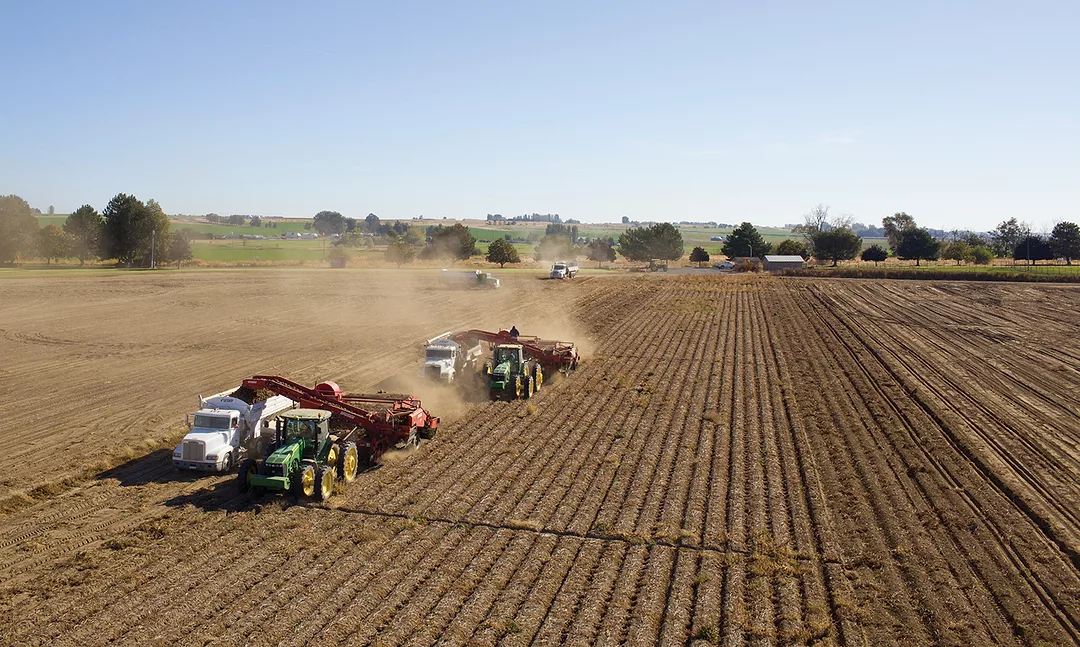
Home » Leading producers: Agriculture adds billions to state’s economy
Leading producers: Agriculture adds billions to state’s economy

May 6, 2018
Washington state is an agricultural powerhouse, leading the nation in the production of apples, grapes, cherries, pears, hops and blueberries.
Supplying the world with millions of tons of apples each year, Washington fills nearly two-thirds of the entire apple market in the United States.
It’s expected the current planted acreage of wine grapes could swell from 55,000 acres to 200,000 acres eventually.
But it’s not just about fruit. While Idaho would like consumers to associate its state with potatoes, Washington grows nearly a quarter of the potato crop for the country.
Washington agricultural production topped $10.6 billion in 2016, according to the U.S. Department of Agriculture.
The state also ranks in the top 10 when it comes to production of milk, thanks to hundreds of dairy farms in operation across the state.
Ed Zurcher owns one of those farms, milking more than a thousand cows a day at his property near Basin City. The 53-year-old has owned Zurcher Dairy since 1990, but in that time, milk prices have fallen drastically.
“Prices suck,” said Jay Gordon, policy director for the Washington State Dairy Federation. “They’re horrible, terrible, rotten.”
Gordon said the payments that farmers, like Zurcher, receive — known as “milk checks” — hit record lows in January 2018, following a steady decline during the past year.
Gordon blames the nation’s lack of a supply management system, which is common for other crops like sugar and peanuts. He said it’s led to a worldwide oversupply that he describes as a “free market free-for-all, survival-of-the-fittest system.”
Zurcher and other milk producers likely will soak up the short-term operating losses by supplying more milk. There’s been a 13 percent increase in the past decade on the average amount of milk produced by a cow. It’s now up to 24,000 pounds for Washington, calculated on a 305-day lactation cycle.
Zurcher’s cows are milked twice a day, with the process beginning at 4 a.m. and cycling through all the cows before starting again at 4 p.m., seven days a week. A two-man crew can milk about 150 cows an hour at the dairy, which is part of the Northwest Dairy Association Cooperative, selling under the Darigold name.
Milk from Zurcher’s farm could end up across the state. A refrigerated tanker arrives once or twice a day to pick up milk and may drive it to Sunnyside, Spokane or Bellevue.
The daily grind that comes with being a dairy farmer results in an industry that new farmers aren’t generally getting into. Gordon’s family has been in the dairy industry for 150 years, and he knows at least one farmer who boasts a family farming history going back 600 years.
As milk prices are drained, Zurcher has been able to retain the 10 full-time workers at his farm. But he said issues like the proposed state carbon tax could have a detrimental effect on an industry already struggling.
“It’s a challenge being an agriculture entity in a blue state,” Zurcher said.
For those trying to weather the storm and stay in business, the main strategies are to increase efficiency or specialize in the product offered. With about 400 dairy farms across the state, some conventional milk farmers have begun to focus on organic milk. But even that specialty has been hit with oversupply. Milk remains the second-highest agricultural commodity in Washington, with a total production value of $1.1 billion in 2016, but that is the lowest annual value since 2010.
Milk is second only to the stronghold on value provided by Washington apples. That domination started in the late 1800s when settlers arrived and found the state, especially the central region, to have naturally-fertile soil. The first orchards were established around water sources, and the Columbia Basin irrigation project helped spread the apple industry throughout Eastern Washington.
And state apple production has been on an upward trend since.
“Acreage has gone up slightly, but production has doubled in the last 30 years,” said Rebecca Lyons, international marketing director for the Washington Apple Commission. State growers produced 80 million cartons of apples in 2004, compared to about 130 million today.
Lyons said the “intensity of the planting” has changed, drastically increasing the number of trees in an orchard. They can now be planted much closer together, which allows for greater ease in picking. In the past, 300 trees were typical per acre. Today, it’s in the thousands.
“When you think about an apple orchard, you think of idyllic trees with a canopy you could have a picnic under. But, today, it’s really just a wall of fruit,” Lyons said.
Using a rootstock with an apple variety grafted directly onto it, Lyons said the result is a more manageable orchard that can be harvested more easily. Every single Washington apple is still picked by hand, which makes labor a key issue for the apple industry. Research is constantly being done to figure out more effective and efficient ways to harvest.
“A robot that could pick apples is kind of the Holy Grail,” Lyons said. No inventions have been commercially viable, with the closest being a motorized platform, known as a “platform picker,” eliminating the need for ladders.
With a 2016 value of $2.39 billion, the apple crop represents nearly a quarter of the total agricultural value for the state of Washington. The Washington Apple Commission has found that the overall consumption of fresh apples in the United States remains stable. About two-thirds of what’s grown stays domestic, while the other third is exported. Washington is responsible for about 90 percent of apples sent outside the U.S., with demand highest in Mexico, Canada and India, where apples are considered exotic.
For the U.S., there’s a lot more competition in stores when it comes to fresh fruit. Crops that were once offered only seasonally can now be found year round. The apple industry works to stay relevant by increasing the types offered.
“Consumers today have more choices than at any time in history on what variety to buy,” Lyons said.

The state’s potato production value reached record highs in 2017 ($888 million) and 2016 ($813 million).
What’s hard to measure with potatoes, though, is the value added through jobs created by the potato industry.
Chris Voigt, executive director for the Washington State Potato Commission, said potatoes are a unique crop because 90 percent of what’s grown is processed into something else.
Those processing jobs make up part of the 36,000 people employed by the potato industry in the state. A January 2016 study by Washington State University-Pullman found that the state’s potato industry generates $7.42 billion in economic output for Washington.
Despite this, potato growers are concerned about the erosion of potato consumption. People tend to eat fewer potatoes as they don’t make home cooking a priority. But the demand for potatoes is still growing on the international front, increasing about 6 percent to 7 percent a year, especially in the Pacific Rim.
Voigt set out to remind people of the health benefits of the basic potato in 2010 when he vowed to spend 60 days eating potatoes for every meal.
The decision came as the USDA was poised to kick potatoes out of federal programs like school lunches.
“I can’t say it translated to sales,” he said, but people’s attitudes toward potatoes saw a small bump around the same time the story made national headlines.
“I’d like to think it reminded people just how healthy and nutritious potatoes are,” he said.
Using that star starch, there’s a goal of increasing the state’s potato production by 25 percent over the next 20 years. This could come through increased yields on current land, but also by finding additional ground to plant and potentially increasing crop rotation through new advances in soil management. Voigt said he believes Washington potatoes can play a key role in supplying food to an ever-increasing worldwide population.
“We’re at a point where we’ve got to provide food to this growing world,” he said.
As the growing population puts increasing demands on products delivered by farmers and ranchers, Washington continues to be front and center in providing hundreds of millions of tons of fruit, vegetables and dairy products throughout the continent and across the world.
Agriculture + Viticulture
KEYWORDS focus agriculture viticulture 2018





